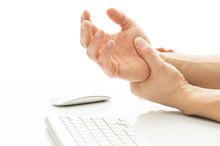Muscle Fatigue, Twitches & Joint Pain
Occasional soreness, muscle twitching and fatigue are common life occurrences that most people experience occasionally. When they happen frequently, however, they are oftentimes symptoms of a deeper medical condition that needs your attention. Consult with your doctor to discuss muscle fatigue, twitching and joint pain that have become a permanent fixture in your life.
Muscle Twitching Defined
Muscle twitches are derived from tiny involuntary muscle contractions. These contractions occur in response to confused signals sent from the brain and spinal cord to strands of nerve fibers within your muscles. Once a group of muscles receive the message -- muscles respond only in small groups -- they begin to contract. Muscle twitching occurs when nerve fibers contract and release abruptly instead of the usual moderate contractions that allow for running, walking and overall body movement.
- Muscle twitches are derived from tiny involuntary muscle contractions.
- Muscle twitching occurs when nerve fibers contract and release abruptly instead of the usual moderate contractions that allow for running, walking and overall body movement.
Normal and Abnormal Twitching
Why Does Crying Give You a Headache?
Learn More
Occasional muscle twitches that do not last longer than a few days are normal and generally go unnoticed. Recurring muscle twitches are often caused by dietary insufficiencies, drug interactions, and side effects or exercise. Twitches that occur in the eyelids, thumbs or calves are generally considered benign symptoms of stress and anxiety, according to the University of Maryland Medical Center. Muscle twitching that is accompanied by muscle fatigue, weakness or sensation loss may indicate an underlying neurological disorder.
- Occasional muscle twitches that do not last longer than a few days are normal and generally go unnoticed.
- Recurring muscle twitches are often caused by dietary insufficiencies, drug interactions, and side effects or exercise.
Peripheral Nerves
Your body’s peripheral nervous system sits outside of your brain and spinal cord where it controls skeletal muscle movement and sensory perceptions. Damage to peripheral nerves -- called peripheral neuropathy -- from either physical trauma or systemic diseases often results in joint pain and muscle fatigue. Compression injuries from repetitive, forceful or awkward activities can also cause peripheral nerve damage. The National Institute of Neurological Disorders and Stroke states that muscle weakness, twitching and joint pain occasionally coincide with inherited peripheral nerve conditions.
- Your body’s peripheral nervous system sits outside of your brain and spinal cord where it controls skeletal muscle movement and sensory perceptions.
- The National Institute of Neurological Disorders and Stroke states that muscle weakness, twitching and joint pain occasionally coincide with inherited peripheral nerve conditions.
Fibromyalgia
Pain at the Back of the Legs Between the Thighs & the Calves
Learn More
Muscle fatigue, joint pain and twitching are all common symptoms of the neurological condition fibromyalgia. Involuntary muscle twitching in fibromyalgia seems to correspond to specific areas of the body called tender points, which tend to irritate nerve fibers. Fibromyalgia sufferers often experience muscle weakness and joint pain due to inactivity of painful and fatigued muscles. Proper nutrition, along with daily exercise and stretching and massaging of sore joints and muscles, may provide some relief.
- Muscle fatigue, joint pain and twitching are all common symptoms of the neurological condition fibromyalgia.
Related Articles
References
- National Multiple Sclerosis Society. MS symptoms.
- American Association of Neurological Surgeons. Spasticity.
- Boyraz I, Uysal H, Koc B, Sarman H. Clonus: definition, mechanism, treatment. Med Glas (Zenica). 2015;12(1):19-26.
- Shawcross DL, Wendon JA. The neurological manifestations of acute liver failure. Neurochem Int. 2012;60(7):662-71. doi:10.1016/j.neuint.2011.10.006
- Shulman C, Annetta V. Images in clinical medicine. Clonus after a stroke. N Engl J Med. 2013;368(2):e2. doi:10.1056/NEJMicm1203111
- Muscular Dystrophy Association. Amyotrophic lateral sclerosis (ALS).
- Leite MA, Orsini M, de Freitas MR, et al. Another perspective on fasciculations: when is it not caused by the classic form of amyotrophic lateral sclerosis or progressive spinal atrophy?. Neurol Int. 2014;6(3):5208. doi:10.4081/ni.2014.5208
- Orsini M, Sztajnbok FR, Oliveira AB, et al. Benign fasciculations and corticosteroid use: possible association? An update. Neurol Int. 2011;3(2):e11. doi:10.4081/ni.2011.e11
- Miller KC, Stone MS, Huxel KC, Edwards JE. Exercise-associated muscle cramps: causes, treatment, and prevention. Sports Health. 2010;2(4):279–283. doi:10.1177/1941738109357299
- National Center for Advancing Translational Sciences. Cramp-fasciculation syndrome.
- Cleveland Clinic. Electromyograms. Updated December 6, 2016.
- Chang E, Ghosh N, Yanni D, Lee S, Alexandru D, Mozaffar T. A review of spasticity treatments: pharmacological and interventional approaches. Crit Rev Phys Rehabil Med. 2013;25(1-2):11–22. doi:10.1615/CritRevPhysRehabilMed.2013007945
- Hersh C MH, Fox RJ. Multiple sclerosis. Cleveland Clinic Center for Continuing Education. June 2014.
- Younger DS. Motor Disorders. Brookfield, CT: Rothstein Publishing; 2015.
Resources
Writer Bio
Based near America's "Gateway to the West," Li St. Michael has been writing professionally since 2005. Her culturally minded articles have appeared on various websites. St. Michael holds a Bachelor of Science in writing from Drury University and is set to receive a Masters degree in international relations in 2011.









